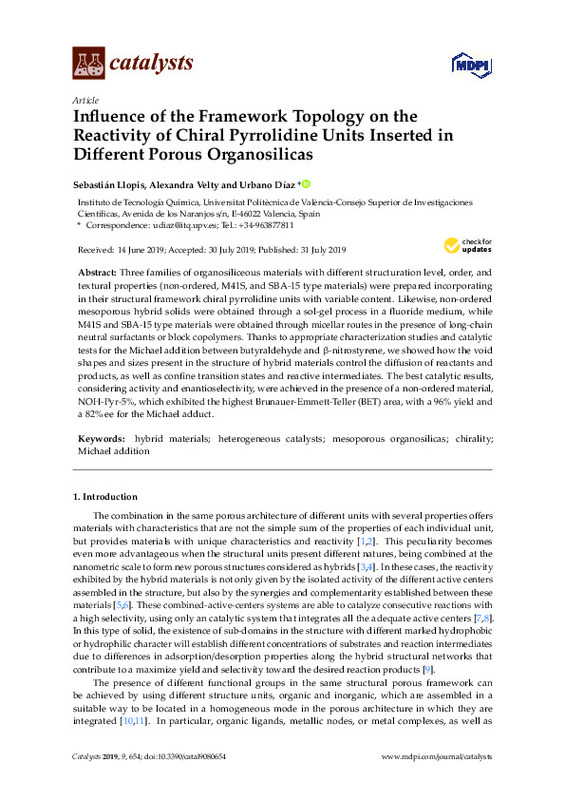Kuschel, A., Drescher, M., Kuschel, T., & Polarz, S. (2010). Bifunctional Mesoporous Organosilica Materials and Their Application in Catalysis: Cooperative Effects or Not? Chemistry of Materials, 22(4), 1472-1482. doi:10.1021/cm903412e
Díaz, U., Brunel, D., & Corma, A. (2013). Catalysis using multifunctional organosiliceous hybrid materials. Chemical Society Reviews, 42(9), 4083. doi:10.1039/c2cs35385g
Kadib, A. E., Molvinger, K., Guimon, C., Quignard, F., & Brunel, D. (2008). Design of Stable Nanoporous Hybrid Chitosan/Titania as Cooperative Bifunctional Catalysts. Chemistry of Materials, 20(6), 2198-2204. doi:10.1021/cm800080s
[+]
Kuschel, A., Drescher, M., Kuschel, T., & Polarz, S. (2010). Bifunctional Mesoporous Organosilica Materials and Their Application in Catalysis: Cooperative Effects or Not? Chemistry of Materials, 22(4), 1472-1482. doi:10.1021/cm903412e
Díaz, U., Brunel, D., & Corma, A. (2013). Catalysis using multifunctional organosiliceous hybrid materials. Chemical Society Reviews, 42(9), 4083. doi:10.1039/c2cs35385g
Kadib, A. E., Molvinger, K., Guimon, C., Quignard, F., & Brunel, D. (2008). Design of Stable Nanoporous Hybrid Chitosan/Titania as Cooperative Bifunctional Catalysts. Chemistry of Materials, 20(6), 2198-2204. doi:10.1021/cm800080s
Horcajada, P., Serre, C., Vallet-Regí, M., Sebban, M., Taulelle, F., & Férey, G. (2006). Metal–Organic Frameworks as Efficient Materials for Drug Delivery. Angewandte Chemie International Edition, 45(36), 5974-5978. doi:10.1002/anie.200601878
Zhang, J., Han, X., Wu, X., Liu, Y., & Cui, Y. (2019). Chiral DHIP- and Pyrrolidine-Based Covalent Organic Frameworks for Asymmetric Catalysis. ACS Sustainable Chemistry & Engineering, 7(5), 5065-5071. doi:10.1021/acssuschemeng.8b05887
Loy, D. A., & Shea, K. J. (1995). Bridged Polysilsesquioxanes. Highly Porous Hybrid Organic-Inorganic Materials. Chemical Reviews, 95(5), 1431-1442. doi:10.1021/cr00037a013
Inagaki, S., Guan, S., Fukushima, Y., Ohsuna, T., & Terasaki, O. (1999). Novel Mesoporous Materials with a Uniform Distribution of Organic Groups and Inorganic Oxide in Their Frameworks. Journal of the American Chemical Society, 121(41), 9611-9614. doi:10.1021/ja9916658
Villaverde, G., Arnanz, A., Iglesias, M., Monge, A., Sánchez, F., & Snejko, N. (2011). Development of homogeneous and heterogenized rhodium(i) and palladium(ii) complexes with ligands based on a chiral proton sponge building block and their application as catalysts. Dalton Transactions, 40(37), 9589. doi:10.1039/c1dt10597c
Melde, B. J., Holland, B. T., Blanford, C. F., & Stein, A. (1999). Mesoporous Sieves with Unified Hybrid Inorganic/Organic Frameworks. Chemistry of Materials, 11(11), 3302-3308. doi:10.1021/cm9903935
García-García, P., Moreno, J. M., Díaz, U., Bruix, M., & Corma, A. (2016). Organic–inorganic supramolecular solid catalyst boosts organic reactions in water. Nature Communications, 7(1). doi:10.1038/ncomms10835
Moreno, J. M., Velty, A., Díaz, U., & Corma, A. (2019). Synthesis of 2D and 3D MOFs with tuneable Lewis acidity from preformed 1D hybrid sub-domains. Chemical Science, 10(7), 2053-2066. doi:10.1039/c8sc04372h
Szőllősi, G., Gombkötő, D., Mogyorós, A. Z., & Fülöp, F. (2018). Surface-Improved Asymmetric Michael Addition Catalyzed by Amino Acids Adsorbed on Laponite. Advanced Synthesis & Catalysis, 360(10), 1992-2004. doi:10.1002/adsc.201701627
Feng, J., Li, X., & Cheng, J.-P. (2017). Enantioselective Organocatalyzed Vinylogous Michael Reactions of 3-Alkylidene Oxindoles with Enals. The Journal of Organic Chemistry, 82(3), 1412-1419. doi:10.1021/acs.joc.6b02582
Bernardi, L., Fochi, M., Carbone, R., Martinelli, A., Fox, M. E., Cobley, C. J., … Carlone, A. (2015). Organocatalytic Asymmetric Conjugate Additions to Cyclopent-1-enecarbaldehyde: A Critical Assessment of Organocatalytic Approaches towards the Telaprevir Bicyclic Core. Chemistry - A European Journal, 21(52), 19208-19222. doi:10.1002/chem.201503352
Afewerki, S., Ma, G., Ibrahem, I., Liu, L., Sun, J., & Córdova, A. (2015). Highly Enantioselective Control of Dynamic Cascade Transformations by Dual Catalysis: Asymmetric Synthesis of Polysubstituted Spirocyclic Oxindoles. ACS Catalysis, 5(2), 1266-1272. doi:10.1021/cs501975u
Monge-Marcet, A., Pleixats, R., Cattoën, X., Man, M. W. C., Alonso, D. A., & Nájera, C. (2011). Prolinamide bridged silsesquioxane as an efficient, eco-compatible and recyclable chiral organocatalyst. New Journal of Chemistry, 35(12), 2766. doi:10.1039/c1nj20516a
Sagamanova, I., Rodríguez-Escrich, C., Molnár, I. G., Sayalero, S., Gilmour, R., & Pericàs, M. A. (2015). Translating the Enantioselective Michael Reaction to a Continuous Flow Paradigm with an Immobilized, Fluorinated Organocatalyst. ACS Catalysis, 5(11), 6241-6248. doi:10.1021/acscatal.5b01746
Betancort, J. M., & Barbas, C. F. (2001). Catalytic Direct Asymmetric Michael Reactions: Taming Naked Aldehyde Donors. Organic Letters, 3(23), 3737-3740. doi:10.1021/ol0167006
[-]









